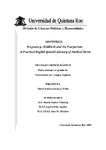Mostrar el registro sencillo del ítem
Obstetrics: pregnancy, Childbirth and the puerperium a practical english-spanish glossary of medical terms.
| dc.contributor.author | Pacheco Tillitt, Mireli Patricia | |
| dc.contributor.other | PEÑA AGUILAR, ARGELIA; 466646 | |
| dc.contributor.other | Mackler, Jane M | |
| dc.date.accessioned | 2023-09-27T19:11:20Z | |
| dc.date.available | 2023-09-27T19:11:20Z | |
| dc.date.issued | 2009 | |
| dc.identifier.uri | http://hdl.handle.net/20.500.12249/3472 | |
| dc.description.abstract | According to Roderick and McGrew (1985, p.134), in ancient cultures, religion and medicine were linked. The earliest known institutions aiming to provide cure were Egyptian temples. Greek temples dedicated to the healer-god Asclepius might admit the sick, who would wait for guidance from the god in a dream. The Romans adopted his worship. Under his Roman name Æsculapius, he was provided with a temple (291 BC) on an island in the Tiber in Rome, where similar rites were performed. As it is mentioned in Wikipedia (n/d), the “Hospital de Jesus Nazareno” in Mexico City is the oldest hospital in North America. It was founded in 1524 with the economic support of conquistador Hernán Cortés to care for poor Spanish soldiers and the native inhabitants. Also, it is known that hospitals are usually funded by the state, health organizations, health insurances or charities, including direct charitable donations. In history, however, they were often founded and funded by religious orders or charitable individuals and leaders. Similarly, modern-day hospitals are largely staffed by professional physicians, surgeons and nurses, whereas in history, this work was usually done by the founding religious orders or by volunteers. During the Middle Ages the hospital could serve other functions, such as almshouse for the poor, hostel for pilgrims, or hospital school. The name comes from Latin hospes (host), which is also the root for the English words hotel, hostel, and hospitality. Today, a hospital is an institution for health care providing treatment by specialized staff and equipment. Some patients in a hospital come just for diagnosis and/or therapy and then leave ('outpatients'); while others are 'admitted' and stay overnight or for several weeks or months ('inpatients'). Hospitals are usually distinguished from other types of medical facilities by their ability to admit and care for inpatients. | |
| dc.description.provenance | Submitted by Guadalupe Castillo Villanueva (castillogm@uqroo.edu.mx) on 2023-09-27T19:09:56Z No. of bitstreams: 1 P361.P32.2009-59622.pdf: 452532 bytes, checksum: 0f5dcd6d28433fb4b1a7756931899fac (MD5) | |
| dc.description.provenance | Approved for entry into archive by Guadalupe Castillo Villanueva (castillogm@uqroo.edu.mx) on 2023-09-27T19:11:20Z (GMT) No. of bitstreams: 1 P361.P32.2009-59622.pdf: 452532 bytes, checksum: 0f5dcd6d28433fb4b1a7756931899fac (MD5) | |
| dc.description.provenance | Made available in DSpace on 2023-09-27T19:11:20Z (GMT). No. of bitstreams: 1 P361.P32.2009-59622.pdf: 452532 bytes, checksum: 0f5dcd6d28433fb4b1a7756931899fac (MD5) Previous issue date: 2009 | |
| dc.format | ||
| dc.language.iso | eng | |
| dc.publisher | Universidad de Quintana Roo | |
| dc.rights.uri | http://creativecommons.org/licenses/by-nc-nd/4.0 | |
| dc.subject | Inglés — Glosarios –Medicina – Español | |
| dc.subject | Español – Glosarios – Medicina -- Inglés | |
| dc.subject.classification | HUMANIDADES Y CIENCIAS DE LA CONDUCTA::LINGÜÍSTICA::LINGÜÍSTICA APLICADA::TRADUCCIÓN | |
| dc.title | Obstetrics: pregnancy, Childbirth and the puerperium a practical english-spanish glossary of medical terms. | |
| dc.type | Trabajo de grado, licenciatura | |
| dc.type.conacyt | bachelorDegreeWork | |
| dc.description.enky | 861 | |
| dc.rights.acces | openAccess | |
| dc.identifier.lcc | P361 | |
| dc.identificator | 4||57||5701||570112 | |
| dc.audience | generalPublic | |
| dc.division | Campus Chetumal Bahía | |
| dc.division.sub | División de Ciencias Políticas y Humanidades | |
| dc.division.programa | Lengua Inglesa |
Ficheros en el ítem
Este ítem aparece en la(s) siguiente(s) colección(ones)
-
Licenciatura [2590]






